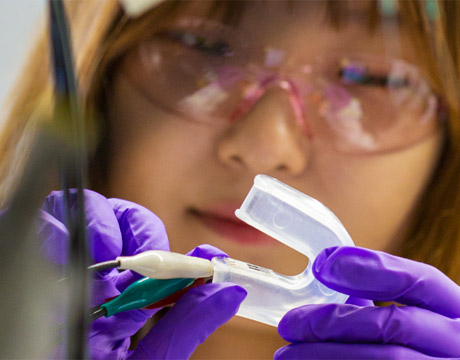Read My Mouth
Read My Mouth


A mouthguard sensor system that monitors health markers. Image: Energy-Efficient Microsystems Lab at UCSD
If you saw someone walking around with a mouthguard, you might think they just woke up and forgot to take it out. But one day it might be a way to alert a doctor to a hidden problem they have. A team at the University of California, San Diego, is hard at work on a mouthguard that may just affect someone’s chances of getting diabetes or other ailments.
“We’ve been excited about the wearables space and there are watches that measure a few medical things but we want to get more information out of them for medical patients, athletes and people interested in building tech that can monitor chemicals,” says Patrick Mercier, assistant professor in electrical and computer engineering, whose earlier experience included working on powering a wireless transmitter from a biologic battery that was located inside the inner ear. “Trying to do that with blood can be invasive so we wanted to look at noninvasive signatures.” They chose to focus on saliva, which can, for example, show high uric acid levels, something which can correlate to risk for diabetes, he says.
A great idea in theory, but the challenge was making the sensors accurate enough and making them last long enough to be effective.
For the screen-printed sensor, the conductive inks are printed and then functionalized with appropriate enzymes that respond electrochemically to a metabolite that is being measured. They are measuring the aforementioned uric acid but they have demonstrated another sensing modality in terms of sensing lactates in saliva as well, he says.
“We’re working on building better sensors—saliva is a different environment to work in because it has proteins and other chemicals that interfere with measurements,” he explains. “For the electronic side, we’re really power limited. We need to use low powered communications protocols like Bluetooth low energy and make sure we’re integrating all of our electronic components well so that this all fits in a reasonable form factor.”
However, he believes that ultimately, Bluetooth low energy will not be low enough energy for these applications. “That’s a challenge for us in the wireless industry and we have to try and address this through new low-power radio technologies,” he says.
They have presently validated using human saliva measurements but have not placed the mouthguard in someone’s mouth, he says. They eventually will apply for Internal Review Board approval to start human testing.
The team also has a goal to use the mouthguard to measure stress levels. “The idea is we look at planes and have hundreds of sensors but, yet, the pilot has none,” says Mercier, the co-director of the Center for Wearable Sensors. “Part of the motivation is to measure biomarkers that represent stress of the pilot so adjustments can be made.”
There’s a long way to go, but Mercier is excited by where they are at this point. “It’s a cutting edge area of research that has implications that are wide from consumer electronics to healthcare,” he says. “Our hope is that it just may make a difference in someone’s life.”
Eric Butterman is an independent writer.
Learn about the latest trends in bioengineering at ASME’s Global Congress onNanoEngineering for Medicine and Biology.
It’s a cutting edge area of research that has implications that are wide from consumer electronics to healthcare.Prof. Patrick Mercier, University of California, San Diego




